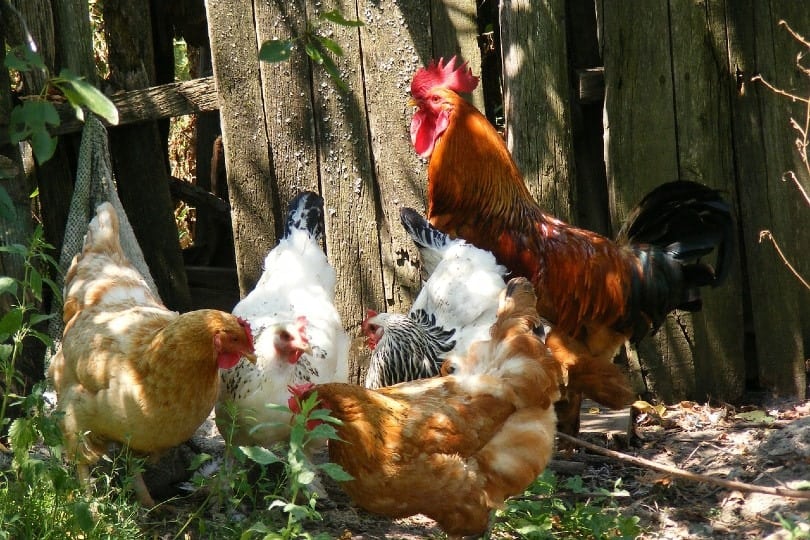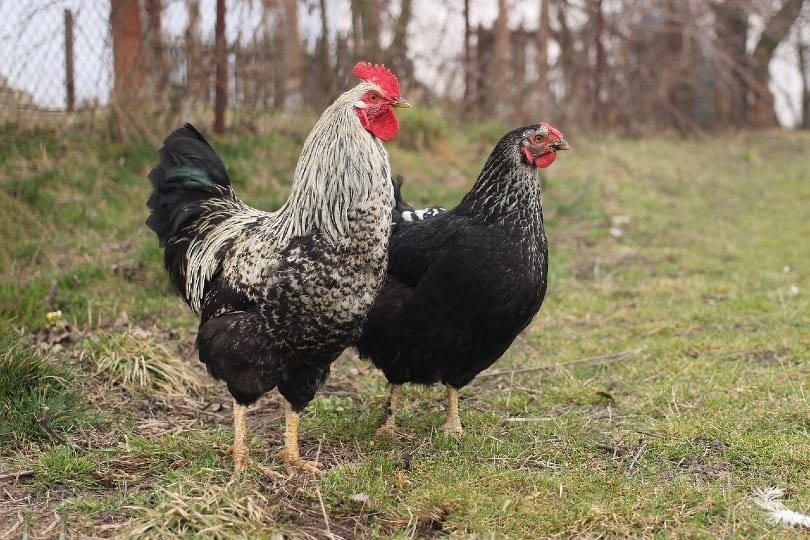Approved by Dr. Luqman Javed
So, you’re ready to join the backyard chicken craze and it’s time to buy your first birds. You’ve weighed the pros and cons and decided you want to keep a rooster with your flock of hens. The only question is how many roosters and hens you should get?
To get the best possible egg production, it’s vital that you maintain the perfect ratio of hens to roosters. A general rule of thumb for the amateur chicken owner is to keep about 10 hens per rooster. The number of hens you can safely keep with your rooster also depends on other factors such as the breed, age, and energy level of your male bird.
In this article, we’ll talk about some general guidelines to follow when picking the right number of hens and roosters. We’ll also go over why it’s important to keep the perfect ratio of hens to roosters and how to help ensure everyone gets along, even if you have multiple roosters.

The Perfect Ratio
The perfect ratio of hens to roosters allows the rooster to cover all the hens without stressing out the hens. It also provides enough hens that they aren’t worn out by the constant attention of the rooster. Roosters, especially young ones, can be rough and aggressive and there need to be enough hens to spread the love, so to speak.
A good rule of thumb is to plan on about 10 hens per rooster. However, some breeds of chicken are possible exceptions to this, and this ratio is just an estimate.
Lighter and more energetic roosters, such as Leghorns, may easily handle up to 15 hens. More laidback chicken breeds, like Orpingtons or Silkies, may not be able to cover as many hens. Keeping a smaller ratio of 1 rooster to 6 to 8 hens is ideal for these mellow birds.
The age of your rooster doesn’t seem to heavily impact how many hens he can handle. Roosters reach sexual maturity at about 4 to 5 months old, and their fertility begins to decline after 50 weeks of age (approximately 1 year old). However, the decline in fertility isn’t of major concern for backyard farms or pets, as they still produce sufficient sperm to handle small flocks.

What Is The Minimum Number of Hens Per Rooster?
If you don’t have the space for a bigger flock but still want a rooster, you might be curious what is the minimum number of hens you can keep. Generally, a rooster needs a minimum of 4 hens but more aggressive breeds, like Rhode Island Reds, might overwhelm even that many chickens and require more.
When keeping a smaller number of hens, you’ll need to monitor your ladies carefully to make sure the rooster isn’t being too rough on them and tiring them out.
- Broken feathers
- Torn skin
- Bald spots
- Hiding from the rooster
Even with a larger group of hens, you’ll still need to chaperone just a bit, especially if you have a young and inexperienced rooster.
Can You Have More Than One Rooster in a Flock?
As a general rule, roosters don’t get along with each other when there are hens around unless they were raised together. The social structure of the flock places the head rooster first and he will guard his hens and his territory fiercely. Any younger roosters in the flock will be shut out from mating with the hens and are much lower on the social ladder.
Upstart young roosters in a flock may decide to challenge the head rooster leading to fights and injuries to both birds. The mellower chicken breeds are more likely to tolerate a flock with more than one rooster. Roosters who grow up together also tend to get along better and might be able to share a flock.
If you are breeding and hatching your own chicks, eventually you’ll end up with more roosters than your original daddy bird. These baby boys can be sold or given away. Others may end up on a dinner plate.
However, if you have the space, you can also keep a flock of roosters together in their own bachelor pad. Without hens to fight over, roosters usually get along just fine. Some chicken keepers let their roosters take shifts with the hens to keep them fresh, rotating them in and out of the bachelor flock.

Keeping the Peace: Managing Your Flock
Once you have your hens and rooster matched up and settled, they’ll organize themselves into a pecking order. Keeping this social structure stable is vital to maintaining the health of your birds. Having a rooster in the flock makes the establishment of the pecking order a little easier, one of the major pros to keeping male birds.
Below the rooster, the hens will line themselves up with the more dominant birds reigning at the top of the social structure and submissive hens taking the lower roles. You’ll need to keep an eye on everyone to make sure the rooster doesn’t pick favorite hens and wear them out while ignoring the other ladies.
Dominant hens may bully the more submissive hens. An overly aggressive hen may even challenge a rooster for being higher up in the pecking order; however, given the size disparity of males and females, this is a rare occurrence. Still, it’s something else for you to keep an eye on. Anytime chickens are added or lost from the flock, the social structure goes through a shakeup and power struggles may occur.
Chicks take the rank of their mother within a flock when they’re still with her. When they’ve been weaned, they are no longer afforded this luxury, and they usually start along the bottom of the pecking order (given their relative size when compared to the adults).
Like we discussed earlier, extra roosters in a flock are in a strange position in the pecking order. Technically, roosters want to be superior to the hens but young roosters have to be careful not to challenge the head man or they may suffer the consequences. If a young rooster does succeed in dethroning the head of the flock, the pecking order will be thrown into disarray again.
To help ensure all your birds stay on good terms, do your part to ensure they have plenty of space to spread out. Eliminate any squabbles over nesting spots or food and water by providing more than enough to go around.
How to Keep More Than One Flock Together
Now that you know the perfect ratio of hens to roosters for a flock, what do you do if you want to keep more than one flock of chickens? We know that roosters will fight each other over hens and space so how do you keep everyone safe?
With enough space, you can successfully keep multiple flocks of hens and roosters. The key is to keep the individual flocks healthy with the right ratio of birds and keep them physically separated from each other. Marking each flock’s territory with a fence or other type of wall will allow them to co-exist on the property without conflict.


Conclusion
While not every chicken keeper has the option to have a rooster, there are definite benefits to doing so. When building your flock, aim for the perfect ratio of hens to roosters by considering the breed, energy level, and age of your chickens.
Your decision will also be influenced by how much space you have for your flock, keeping in mind that the minimum number of hens per rooster is about four. With planning and careful monitoring of your fluffy friends, you can enjoy fresh eggs and cute baby chicks for years to come!
Featured Image Credit: Pavlofox, Pixabay
